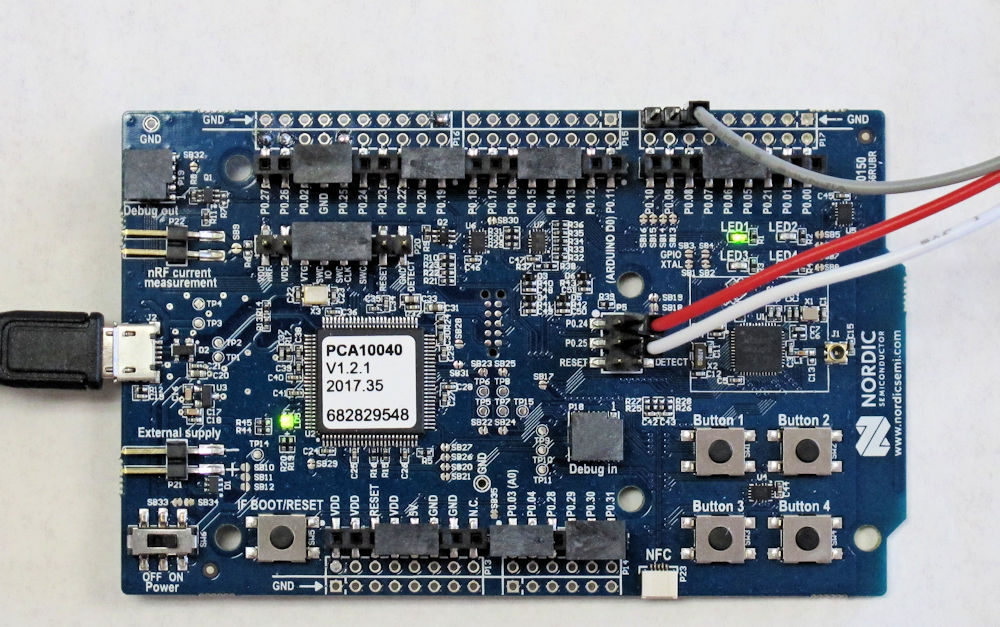There’s a reason why I’m sitting in a conference room located on the second floor of a small Sunnyvale office building across the street from the Sunken Gardens Golf Course. I’m sitting across the table from Voler Systems’ president Walt Maclay with a pulse plethysmograph optical sensor (that’s an infrared photoelectric sensor used to record changes in pulsatile blood flow from a finger or toe) clipped to my right forefinger. Instead of the usual static, boring PowerPoint slide on the conference room’s screen, I see live on-screen data tracking my pulse rate with a 1Hz update rate.
The projection on the screen says my heart rate’s 59 beats/minute.
“You’re very healthy,” says Maclay. His laptop displays a live bar graph coming over a Wi-Fi connection from a cloud-based IoT data-intelligence platform called Medium One. The Medium One app generates the real-time bar graph from medical IoT data that it gets over Wi-Fi from a $10 Raspberry Pi Zero W acting as a cheap-as-chips RF bridge between Bluetooth Low Energy (Bluetooth LE) and Wi-Fi. The Raspberry Pi Zero W gets my pulse-rate data from a Nordic Semiconductor NRF52-DK (shown in Figure 1) over a Bluetooth LE connection.
The NRF52-DK is a development kit for Nordic’s nRF52832 SoC, which incorporates a 64MHz, 32-bit Arm Cortex-M4F CPU coupled with as much as 64Kbytes of RAM and 512Kbytes of on-chip Flash memory. The nRF52832 SoC also incorporates a 2.4GHz RF transceiver that supports Bluetooth Low Energy, ANT, and proprietary 2.4 GHz protocol stacks. This SoC is a low-power IoT and IIoT machine.

Figure 1: Voler Systems’ Universal Health-Sensor Platform is based on Nordic Semiconductor’s NRF52-DK development kit for the Nordic’s nRF52832 SoC.
The NRF52-DK development kit resting on the conference room table in front of me is connected to the pulse plethysmograph optical sensor clipped to my finger. The sensor generates an analog signal that’s piped directly into one of the nRF52832 SoC’s eight 12-bit, 200K samples/sec ADC channels using the gray, red, and white wires shown in Figure 1 above.
If you had to design this entire medical IoT system from scratch, including the RF circuitry and stacks, and get it all working, it might take you a while. Quite a while. That’s why Voler Systems, a company that’s specialized in developing wearable and medical sensor systems since 1980, has put all of these pieces together to create what it’s calling the “Universal Health-Sensor Platform”—for itself.
You see, Voler’s customers often don’t have a lot of time. They need quick prototypes so that they can:
- Gather physiological data potentially related to a medical condition or complication to help refine either a diagnosis or prescribed therapy
- Test a wearable device sensor or sensors to confirm that the measurement can be made as planned
- Provide hypothesis testing for medical research or clinical care, or to test some other medical hypotheses
Voler’s clients need to gather this data or possibly conduct these clinical trials quickly so that they can attract investment. You probably know how investors often are. If the early trials take too long because the prototype systems require a lot of development and debug time, investors are likely to lose interest and wander off in search of a faster return on their money. Most investors – most of the successful ones anyway – are clued into the velocity of money. So Voler needed a way to take a client’s ideas for a wearable IIoT-based sensor system and quickly turn them into a working system.
It turns out that there are a lot of parameters to sense on the human body including:
- Temperature
- Heart rate
- Oxygen concentration (pulse plethysmograph)
- ECG (heart activity)
- EEG (brain activity)
- EMG (muscle activity)
- Skin conductance
- Body impedance
- Acceleration
- Breathing
- Leg diameter/swelling
- Blood pressure
- Glucose level
Many sensors have been developed to measure all of these parameters. Each sensor is different and has different interfacing requirements. Some sensors require additional signal conditioning.
For some medical projects, it’s not immediately clear which parameters are the right ones to collect. Thus the need to quickly prototype a system and do some initial research. A medical sensor platform therefore needs to be able to collect and process a lot of data so that the clinical team can determine the right type of sensor to use, the right place on the body for wearing the sensor, the best software algorithm to process the data from that sensor, and the best way to combine the data from all of the sensors. Different clinical trials may require different sensor combinations and different methods for collating and presenting the collected data. That’s a lot of stuff to prototype, especially for a venture-oriented project.
Like most startups, medical IIoT startups often don’t have much money to start with, and they are pressed for time to gather the information that will justify the investment of venture capital. That’s why Voler created the Universal Health-Sensor Platform—as a rapid-prototyping kit for wearable medical IIoT devices.
The platform consists of at least three major pieces. First, there’s the Nordic Semiconductors NRF52-DK development kit and all of the code needed to make it work. This kit and the underlying nRF52832 SoC form a low-power foundation for all sorts of RF-based IoT and IIoT devices. Then there’s the Medium One cloud-based, Python-scripted IoT platform. It has APIs that can trigger workflows in real time and a big-data back end that can perform heavy-duty real-time analytics on the incoming data from multiple IoT devices. Finally, there’s the code running on the inexpensive Raspberry Pi W board that turns the board into a wireless bridge between WiFi and Bluetooth LE. The bridge allows the medical device based on the Nordic Semi board to minimize power consumption by minimizing the transmission distance.
But Maclay tells me that Voler did not develop the Universal Health-Sensor Platform for its customers. He says that his customers usually do not have the engineering expertise needed to use a platform like this directly. Voler pre-engineered this platform for its own use. Why? Because the platform provides a way for Voler to use its decades of experience in new-product design, sensors, and medical devices to quickly deliver a low-cost, proof-of-concept system to its clients. In other words, this platform is a competitive advantage for Voler.
From Voler’s perspective, the chief advantages it gets from the Universal Health-Sensor Platform are:
- Fast, low-cost development of a system that’s pre-engineered to send data to the cloud
- Quick-start sensor testing enabled by collection of real data with functional wearable prototype devices
- Ability to quickly and easily add new sensors to a basic design
- Real-time data collection and processing locally or in the cloud
- Portable code that can be easily ported to production designs
- Compact size and portability: battery-powered prototypes based on the platform can be used on human subjects
Finally, the Universal Health-Sensor Platform showcases Voler’s experience in selecting sensors and incorporating them onto devices.
Now you may not be and may never be a prospect for Voler’s services. Maybe you don’t even develop medical IoT devices. But that’s not really the point. Many engineering teams create kits like this for their own internal use. What I found interesting about Voler’s approach to creating the Universal Health-Sensor Platform was the farsighted perspective in spending the time and effort needed to create a comprehensive, application-specific IoT kit like this—to save itself a significant amount of development time on future projects—and Voler’s marketing savvy to publicly present the kit to customers and prospects as a real differentiating advantage for Voler.
There’s a lot to learn from this little story, both from an engineering and a marketing perspective.






3 thoughts on “A Kit of Its Own: Voler Systems’ Health-Sensor Platform”